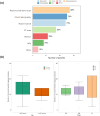Early stage breast cancer follow-up in real-world clinical practice: the added value of cell free circulating tumor DNA
- PMID: 35396978
- PMCID: PMC9114063
- DOI: 10.1007/s00432-022-03990-7
Early stage breast cancer follow-up in real-world clinical practice: the added value of cell free circulating tumor DNA
Abstract
Purpose: Physical examinations and annual mammography (minimal follow-up) are as effective as laboratory/imaging tests (intensive follow-up) in detecting breast cancer (BC) recurrence. This statement is now challenged by the availability of new diagnostic tools for asymptomatic cases. Herein, we analyzed current practices and circulating tumor DNA (ctDNA) in monitoring high-risk BC patients treated with curative intent in a comprehensive cancer center.
Patients and methods: Forty-two consecutive triple negative BC patients undergoing neoadjuvant therapy and surgery were prospectively enrolled. Data from plasma samples and surveillance procedures were analyzed to report the diagnostic pattern of relapsed cases, i.e., by symptoms, follow-up procedures and ctDNA.
Results: Besides minimal follow-up, 97% and 79% of patients had at least 1 non-recommended imaging and laboratory tests for surveillance purposes. During a median follow-up of 5.1(IQR, 4.1-5.9) years, 13 events occurred (1 contralateral BC, 1 loco-regional recurrence, 10 metastases, and 1 death). Five recurrent cases were diagnosed by intensive follow-up, 5 by symptoms, and 2 incidentally. ctDNA antedated disseminated disease in all evaluable cases excepted two with bone-only and single liver metastases. The mean time from ctDNA detection to suspicious findings at follow-up imaging was 3.81(SD, 2.68), and to definitive recurrence diagnosis 8(SD, 2.98) months. ctDNA was undetectable in the absence of disease and in two suspected cases not subsequently confirmed.
Conclusions: Some relapses are still symptomatic despite the extensive use of intensive follow-up. ctDNA is a specific test, sensitive enough to detect recurrence before other methods, suitable for clarifying equivocal imaging, and exploitable for salvage therapy in asymptomatic BC survivors.
Keywords: Breast cancer; Circulating tumor DNA; Follow-up; Imaging.
© 2022. The Author(s).
Conflict of interest statement
ELR, MCD, MS, EO, MV, SF, GVB, GS, GA, MGD, and VC: none; FGdB: speakers bureau honoraria from BMS, Eli Lilly, Roche, Amgen, AstraZeneca, Gentili, Fondazione Menarini, Novartis, MSD, Ignyta, Bayer, Noema SRL, ACCMED, DEPHAFORUM SRL, Nadirex, Roche, Biotechspert Ltd., PriME Oncology, Pfizer, consultant/advisory board fees from BMS, Tiziana Life Sciences, Celgene, Novartis, Servier, Phanm Research Associated, Daiichi Sankyo, Ignyta, Amgen, Pfizer, Roche, Teogarms, and Pierre Fabre; GP: honoraria from Roche, GSK, Genomic Health, and Hybrid Genetic; SDC: consulting fees from Pierre-Fabre, IQVIA.
Figures


Similar articles
-
Association of Circulating Tumor DNA and Circulating Tumor Cells After Neoadjuvant Chemotherapy With Disease Recurrence in Patients With Triple-Negative Breast Cancer: Preplanned Secondary Analysis of the BRE12-158 Randomized Clinical Trial.JAMA Oncol. 2020 Sep 1;6(9):1410-1415. doi: 10.1001/jamaoncol.2020.2295. JAMA Oncol. 2020. PMID: 32644110 Free PMC article. Clinical Trial.
-
Blood-based genomics of triple-negative breast cancer progression in patients treated with neoadjuvant chemotherapy.ESMO Open. 2021 Apr;6(2):100086. doi: 10.1016/j.esmoop.2021.100086. Epub 2021 Mar 17. ESMO Open. 2021. PMID: 33743331 Free PMC article.
-
Circulating Tumor DNA and Late Recurrence in High-Risk Hormone Receptor-Positive, Human Epidermal Growth Factor Receptor 2-Negative Breast Cancer.J Clin Oncol. 2022 Aug 1;40(22):2408-2419. doi: 10.1200/JCO.22.00908. Epub 2022 Jun 4. J Clin Oncol. 2022. PMID: 35658506 Free PMC article.
-
Minimal residue disease detection in early-stage breast cancer: a review.Mol Biol Rep. 2025 Jan 7;52(1):106. doi: 10.1007/s11033-024-10198-0. Mol Biol Rep. 2025. PMID: 39777588 Review.
-
Circulating Tumor DNA as a Novel Biomarker Optimizing Treatment for Triple Negative Breast Cancer.Clin Breast Cancer. 2023 Jun;23(4):339-349. doi: 10.1016/j.clbc.2023.02.012. Epub 2023 Mar 2. Clin Breast Cancer. 2023. PMID: 36966079 Review.
Cited by
-
Association of ctDNA detection and recurrence assessment in patients with neoadjuvant treatment.Cancer Med. 2023 Oct;12(19):19794-19806. doi: 10.1002/cam4.6544. Epub 2023 Sep 25. Cancer Med. 2023. PMID: 37746916 Free PMC article. Review.
-
Surveillance for Distant Metastasis in Breast Cancer Patients Who Underwent Contemporary Management: A Report from the Korean Breast Cancer Society Survivor Research Group.Ann Surg Oncol. 2024 Oct;31(10):6774-6785. doi: 10.1245/s10434-024-15665-3. Epub 2024 Jul 5. Ann Surg Oncol. 2024. PMID: 38969851 Free PMC article.
-
Circulating Tumor DNA in Early and Metastatic Breast Cance-Current Role and What Is Coming Next.Cancers (Basel). 2024 Nov 22;16(23):3919. doi: 10.3390/cancers16233919. Cancers (Basel). 2024. PMID: 39682108 Free PMC article. Review.
-
Circulating tumor DNA: from discovery to clinical application in breast cancer.Front Immunol. 2024 Apr 30;15:1355887. doi: 10.3389/fimmu.2024.1355887. eCollection 2024. Front Immunol. 2024. PMID: 38745646 Free PMC article. Review.
-
Use of ctDNA in early breast cancer: analytical validity and clinical potential.NPJ Breast Cancer. 2024 Jun 19;10(1):50. doi: 10.1038/s41523-024-00653-3. NPJ Breast Cancer. 2024. PMID: 38898045 Free PMC article. Review.
References
-
- Barni S, Venturini M, Molino A et al (2011) Importance of adherence to guidelines in breast cancer clinical practice. The Italian experience (AIOM). Tumori 97(5):559–563 - PubMed
-
- Cardoso F, Kyriakides S, Ohno S et al (2019) Early breast cancer: ESMO Clinical Practice Guidelines for diagnosis, treatment and follow-up. Ann Oncol 30(8):1194–1220 - PubMed
MeSH terms
Substances
LinkOut - more resources
Full Text Sources

